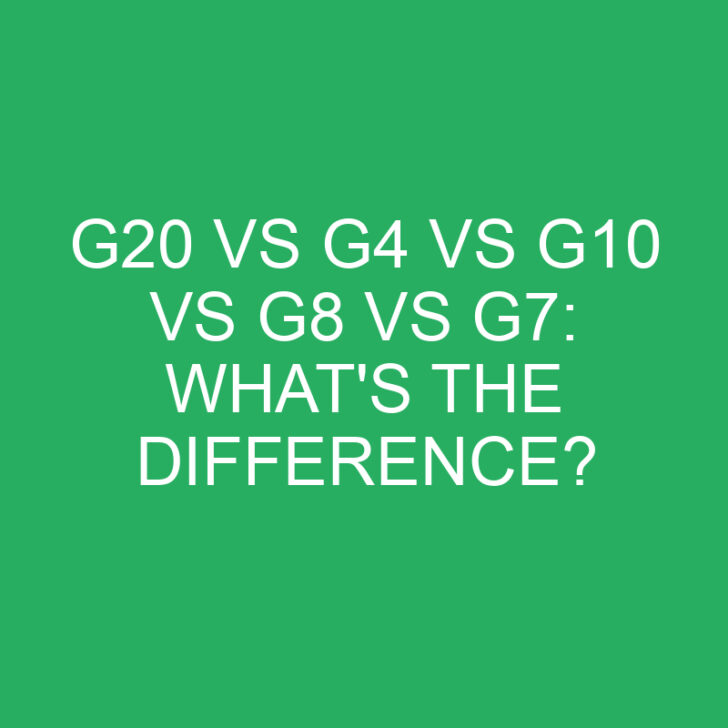In the realm of global governance and economic cooperation, various groups have emerged to address shared challenges, foster collaboration, and promote dialogue among member nations. Among these groups, the G20, G4, G10, G8, and G7 are prominent entities that play significant roles in shaping international policies and initiatives. In this article, we’ll explore the differences between these groups, examining their composition, objectives, and functions.
Post Contents
1. G20 (Group of Twenty)
The G20 is a forum consisting of 19 countries and the European Union, representing the world’s major economies. Established in 1999 in response to the financial crises of the late 1990s, the G20 aims to promote international financial stability and sustainable economic growth through dialogue and cooperation among member nations.
The G20 holds annual summits where leaders discuss a wide range of economic and financial issues, including trade, investment, fiscal policy, and development. The G20 member countries collectively account for approximately 80% of global GDP and two-thirds of the world’s population.
Functions of the G20:
- Facilitating coordination on macroeconomic policies to foster economic stability and growth.
- Addressing global financial imbalances, trade tensions, and systemic risks to the international financial system.
- Promoting cooperation on issues such as climate change, digitalization, and sustainable development.
- Providing a platform for dialogue and consensus-building among diverse stakeholders, including government officials, central bank governors, and international organizations.
2. G4 (Group of Four)
The G4 is a coalition of four countries—Brazil, Germany, India, and Japan—that advocate for reform of the United Nations Security Council (UNSC) to expand its membership and enhance its representativeness. Formed in the early 2000s, the G4 countries seek permanent seats on the UNSC, along with veto power, to reflect the geopolitical realities of the 21st century and address the perceived imbalance of power within the council. The G4 promotes its agenda through diplomatic efforts and negotiations within the UN General Assembly and other international forums.
Functions of the G4:
- Lobbying for reforms to the UNSC to better reflect contemporary geopolitical realities and ensure greater inclusivity and effectiveness in decision-making.
- Advocating for expanded permanent membership in the UNSC, with the inclusion of Brazil, Germany, India, and Japan as new permanent members.
- Engaging in diplomatic outreach and negotiations with other UN member states to build support for UNSC reform proposals.
3. G10 (Group of Ten)
The G10 is an informal group of eleven industrialized nations—Belgium, Canada, France, Germany, Italy, Japan, the Netherlands, Sweden, Switzerland, the United Kingdom, and the United States—originally established in 1962 to coordinate monetary policies and manage the international monetary system. While the G10 no longer holds regular meetings, its members continue to collaborate on issues related to monetary policy, exchange rates, and financial stability through various channels, such as the Bank for International Settlements (BIS) and the International Monetary Fund (IMF).
Functions of the G10:
- Discussing and coordinating monetary policy actions among member countries to maintain exchange rate stability and address currency fluctuations.
- Collaborating on financial regulation, banking supervision, and crisis management to safeguard the stability of the international financial system.
- Providing a platform for dialogue with emerging economies and other stakeholders on key financial and economic issues.
4. G8 (Group of Eight)
The G8 was a forum comprising eight major industrialized democracies—Canada, France, Germany, Italy, Japan, Russia, the United Kingdom, and the United States—that convened annually to discuss global economic and political issues. Established in the 1970s, the G8 expanded its agenda beyond economic matters to include topics such as security, climate change, and development cooperation. However, the group faced criticism for its limited representation and exclusivity, leading to calls for broader inclusion of emerging economies.
Functions of the G8:
- Discussing and coordinating policies on economic growth, trade, energy, environment, and security to address shared challenges and promote global stability.
- Providing a platform for high-level dialogue and collaboration among world leaders on pressing international issues.
- Engaging in initiatives to support development, humanitarian assistance, and peacebuilding efforts in regions affected by conflict, poverty, and natural disasters.
5. G7 (Group of Seven)
The G7 is an informal forum consisting of seven major advanced economies—Canada, France, Germany, Italy, Japan, the United Kingdom, and the United States—that meet annually to address pressing global challenges and coordinate policy responses. Originally formed in the 1970s as the G6, the group expanded to include Canada in 1976, becoming the G7. The G7 discussions cover a wide range of topics, including economic growth, trade, climate change, security, and global health. In recent years, the G7 has emphasized cooperation on issues such as pandemic preparedness, climate action, and economic recovery.
Functions of the G7:
- Addressing pressing economic challenges, including fiscal policy coordination, financial regulation, and trade liberalization, to promote economic growth and stability.
- Promoting democratic values, human rights, and the rule of law on the international stage.
- Discussing and coordinating responses to global crises, such as pandemics, terrorism, and climate change, to mitigate their impact and foster resilience.
Conclusion
In summary, the G20, G4, G10, G8, and G7 represent distinct entities with unique compositions, objectives, and functions in the realm of global governance and economic cooperation. While the G20 focuses on financial and economic matters, the G4 advocates for UN Security Council reform, the G10 collaborates on monetary policies, and the G8 and G7 address broader political and economic challenges. Understanding the differences between these groups is essential for comprehending their roles in shaping international policies and fostering dialogue among nations.
